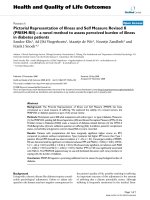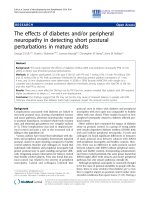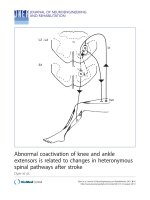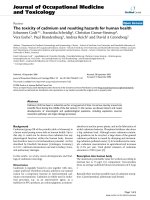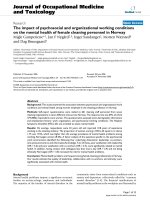Báo cáo hóa học: " Self-assembled monolayer of designed and synthesized triazinedithiolsilane molecule as interfacial adhesion enhancer for integrated circuit" pdf
Bạn đang xem bản rút gọn của tài liệu. Xem và tải ngay bản đầy đủ của tài liệu tại đây (1.05 MB, 5 trang )
NANO EXPRESS Open Access
Self-assembled monolayer of designed and
synthesized triazinedithiolsilane molecule as
interfacial adhesion enhancer for integrated circuit
Fang Wang
*
, Yanni Li, Yabin Wang and Zhuo Cao
Abstract
Self-assembled monolayer (SAM) with tunable surface chemistry and smooth surface provides an approach to
adhesion improvement and suppressing deleterious chemical interactions. Here, we demonstrate the SAM
comprising of designed and synthesized 6-(3-triethoxysilylpropyl)amino-1,3,5-triazine-2,4-dithiol molecule, which can
enhance interfacial adhesion to inhibit copper diffusion used in device metallization. The formation of the
triazinedithiolsilane SAM is confirmed by X-ray photoelectron spectroscopy. The adhesion strength between SAM-
coated substrate and electroless deposition copper film was up to 13.8 MPa. The design strategy of
triazinedithiolsilane molecule is expected to open up the possibilities for replacing traditional organosilane to be
applied in microelectronic industry.
Keywords: adhesion, copper, diffusion barrier, self-assembled monolayer, surface chemistry
Introduction
Isolating individual components of nanoscale architectures
comprised of thin films or nanostructures is a critical chal-
lenge in micro- and nanoscale device fabrication [1]. One
important example that illustrates this challenge could be
seen in Cu-interconnected sub-100-nm device structures,
which require less than 5-nm-thick interfacial layers to
inhibit Cu diffusion into adjacent dielectrics [2]. Conven-
tional interfacial barrier layers such as TaN, Ta, Ti, TiN,
or W have already been optimized in microelectronic
applications. However, such “thick” layers are not suitable
for micro- and nanoscale device fabrication, and the above
materials cannot form uniform and continuous film below
5 nm in thickness [3]. The barrier layer thickness must be
minimized while maintaining high-performance diffusion
barrier properties and good adhesion strength with neigh-
boring layers [4]. Another significant example is seen
in the adhesion between copper and substrate in printed
circuit board technology.
An alternative to the above interfacial layer is the
organic self-assembled monolayer (SAM) [5] with sub-
nanometer dimensions. The SAM [6,7] composed of
short aliphatic chains with desired terminal function
groups has been investigated by modifying surface prop-
erties for the above requirement. The selectivity a nd
adhesion strength between the function group of SAM
and the substrate impact the film packing density and
thermal stability, and the chain length also has influence
on the packing density and order. In recent years,
G. Ramanath has reported the technique of fabricating
SAM with the organosilanes as Cu diffusion barrier layer,
and i nterfacial adhesion in microelectronics devices
[2,8-12]. The results showed that the SAM inhibited Cu
diffusion into substrate interface and enhanced the inter-
facial adhesion to increase the device lifetime [8,13]. This
technique has two advantages: (a) a strong interfacial
bonding which can immobilize Cu, and (b) the creation
of a vacuum-like potential barrier between Cu and the
dielectric layer to inhibit Cu ionization and transport
[14]. The former can be achieved t hrough strong, local
chemical interaction by choosing appropriate terminal
groups, an d the latter can be accomplished by using
SAM with suitable chain length or the introduction of
aromatic group. This technique offers the potential for
tailoring effective barriers with decreased thickness.
The organosilane molecules used to fabricate SAM as
functional interfacial layer have been widely investigated.
* Correspondence:
College of Science, Northwest Agriculture and Forest University, Xi Nong
Road No. 22, Yangling, Shaanxi 712100, China
Wang et al. Nanoscale Research Letters 2011, 6:483
/>© 2011 Wang et al; licensee Springer. This is an Open Access article distributed under the terms of the Creative Commons Attribution
License ( icenses/by/2.0), which permits unrestricted use, distribution, and reproduction in any medium,
provided the original work is properly cited.
Table 1 shows chemical formula and nomenclature of
the self-assembled organ osilanes commonly used in
electronic industry or previous researches.
FromtheresultsofTable1,wecanlearnthatthe
mercapto-silane (SAM1), am ino-silane (SAM2 [15]), and
pyridyl-silane (S AM4) are excellent coupling agents
between substrates and Cu to act as interfacial adhesion
enhancer. Compared with aliphatic groups, larger
volume organosilanes with the aromatic ring (SAM4,
SAM5, SAM6, and SAM7 [16]) sterically hinder copper
diffusion. Therefore, the ideal organosilane molecules
should be with both aromatic ring and terminal function
group which have high reactivity with copper. In recent
years, studies have been mainly focused on the
approaches of Cu metallization including chemical
vapor deposition, physical vapor deposition, electroless
depo sition (ELD), and electroplating. Cu ELD was espe-
cially emphasized in future interconnect technology.
However, the organosilanes utilized in this technique
were mainly mercap topropyltrimethoxysilane (MPTMS;
SAM1 [3,9-11]) and aminopropyltrimethoxysilane
(APTMS; SAM2 [4,9,17]). So far, no research has been
carried out on the modification of organosilane, and it is
necessary to design and synthesize functional organosi-
lane molecule.
Our group has focused on the triazinedithiols (TDTs)
[18-20] for many years. With two mercapto groups and
aromatic ring with nitrogen atom, TDTs combine the
advantages of SAM1 and SAM2, which have high reactiv-
ity with copper. Besides, nitrogen atom that existed
between the two mer capto groups is different with
SAM4, which possesses a better space position for copper
immobilization. But the triazinedithiols could not react
with the substrate for lack of silane group (Si-(OR)
3
).
Therefore, our research concentrates on the combination
of triazinedithiols and silane (see Figure 1).
In this paper, we demonstrate a designed and synthesized
triazinedithiolsilane molecule - 6-(3-t riethoxysilylpropyl)
amino-1,3,5-triazine-2,4-dithiol monosodium salt (abbre-
viation, TESPA, see Figure 1) according to the strategies
mentioned. TESPA has three active sites which r efer to
two mercapto groups [21] and a nitrogen atom. We also
preliminarily investigate the adhesion strength between
ELD copper film and TESPA SAM to verify whether it can
be used as adhesion enhancer and diffusion barrier in
device applications.
Experimental
The chemical structure of TESPA was identified by
nuclear magnetic resonance (NMR), Fourier transform
infrared spectroscopy (FT-IR), and mass spectroscopy
(MS) (The data are available in Additional file 1).
1
H
NMR and
13
CNMRspectrawererecordedbyBruker
AC 400 with 500 MHz (Bruker Daltonics, Billerica, MA,
USA). FT-IR spectra were measured using Bruker TEN-
SOR 37 (Bruker Daltonics). MS was recorded by LCQ-
Fleet (Thermo Scientific, Waltham, MA, USA).
TESPA SAM was fabricated on epoxy resin surface.
The epoxy resin surface was treated by corona discharge
for 10 s to facilitat e the formation of SAM through sur-
face hydroxylation. TESPA SAM was obtained by dip-
ping the epoxy resin into 2.5 mM TESPA monomer
ethanol-water (V/V = 95:5) solution for 5 min at room
temperature. The substrate was dried with nitrogen gas
and cured at 120°C for 20 min. Then, a Sn-Pd
II
colloidal
solution was used as a catalyst precursor [22], which
was prepared via precise control of sequential hydrolysis
of Pd
II
species according to the hydrolysis mechanism of
Pd
II
salts in a chloride-rich aqueous solution. The elec-
troless deposition bath was prepared according to recent
study [23]. X-ray phot oelectron spectroscopy (XPS) was
performed to investigate the elemental composition of
surface by using ULVAC PHI-5600 spectrometer (Ulvac
Technologies, Inc., Methuen, MA, USA). The adhesion
strength between ELD copper film and TESPA SAM-
coated epoxy resin substrate was investigated by T-peel
test using an autograph S-100 apparatus (Shimadzu Cor-
poration, Kyoto, Japan).
Results and discussion
TESPA was synthesized by the reaction of cyanuric
chloride, 3-aminopropyltriethoxy silane (APTES), and
NaSH according to the strategy described in the Figure 1.
The stirring tetrahydrofuran (THF) solution of cyanuric
chloride (0.1 mol) was added with APTES (0.1 mol) over
a period of 60 min. And then the reaction mixture w as
added with THF solution of triethylamine (0.12 mol) for
1-day reaction. After, the solvent was removed under
vacuum to yiel d 6-(3-triethoxysilylpropyl)amino-1,3,5-
triazine-2,4-dichloride. NaSH ethanol solution was added
dropwise for 2-h reaction to the ethanol solution of the
dichloride. After, the solvent was removed under vacuum
Table 1 Chemical formula and nomenclature of the self-
assembled organosilanes usually used in previous
researches
Molecule Chemical formula Name
SAM1 HSCH
2
CH
2
CH
2
Si
(OCH
3
)
3
(3-Mecaptopropyl)trimethoxysilane
SAM2
12
H
2
NCH
2
CH
2
CH
2
Si
(OCH
3
)
3
(3-Aminopropyl)trimethoxysilane
SAM3 CH
3
CH
2
CH
2
Si(OCH
3
)
3
(n-Propyl)trimethoxysilane
SAM4
3-[2-(Trimethoxysilyl)ethyl]pyridine
SAM5
2-(Trimethoxysilyl)ethylbenzene
SAM6
Phenyltrimethoxysilane
SAM7
13
2-(Diphenylphosphino)
ethyltriethoxysilane
Wang et al. Nanoscale Research Letters 2011, 6:483
/>Page 2 of 5
to yield TESPA. Yield was 75.6%, and m.p. > 203°C. Ele-
mental analysis calculation for C
12
H
23
N
4
S
2
O
3
NaSi was:
C, 37.29%; H, 6.00%; N, 14.49%; however, found was: C,
37.46%; H, 6.03%; and N, 14.44%. The results of NMR,
FT-IR, and MS also suggest that TESPA have been
synthesized (see Additional file 1).
The XPS spectra of untreate d and TESPA-treated
epoxy resin substrate are shown in Figure 2. It can be
seen that only the peaks of C1s, O1s, and N1s are
observed for the untreated substrate, while the peaks o f
N1s, S2s, S2p, Si2s, and Si2p corresponding to the
TESPA SAM-covered substrate. The results confirmed
the formation of the TESPA SAM on the epoxy resin
substrate. It can be concluded that the Si-OH groups of
hydrolyzedTESPA(seeFigure1)reactwiththepolar
groups on the pre-treated epoxy resin surface to form
theTESPASAM.ThethicknessoftheTESPASAM
was about 2.8 nm.
The results of XPS for the TESPA SAM before and
after Pd catalyzation are shown in Figure 3. The pre-
sence of Sn3p, Sn3d, Pd3s, Pd3p, and Pd3d peaks sug-
gests the adsorption of catalyst to TESPA SAM-coated
surface, and the designed TESPA m olecule covalently
binds colloidal Pd
II
catalysts, which can promote ELD
copper film onto the TESPA SAM-coated surface [22].
The surface image of TESPA SAM-coated epoxy resin
substrate after ELD copper isshowninFigure4.Itcan
be seen that the surface is uniform and compact. The
adhesion strength between TESPA SAM-coated epoxy
resin and ELD copper film was up to 13.8 MPa, which
could satisfy the purpose of TESPA SAM as adhesion
enhancer and diffusio n barrier layer, while the adhesion
strength between non-TESPA-treated substrate and ELD
copper film was only 1.2 MPa. It is clearly indicated that
the TESPA SAM can be applied as i nterfacial adhesion
enhancer and diffusion barrier. It is expected that
Figure 1 A strategy schema and designed molecule. (R = Cl; R’ =NH
2
(CH
2
)
3
;R” =CH
2
CH
3
; Rx = NH (CH
2
)
3
).
Figure 2 XPS survey spectra of epoxy resin surface: (a)
uncoated and (b) TESPA SAM-coated. X-ray source is
monochromated Al Ka ray. Testing area is 800 × 2,000 μm. Takeoff
angle is 45°. The pressure in the preparation chamber is less than
10
-7
Torr and less than 4 × 10
-10
Torr in the analysis chamber.
Figure 3 XPS survey spectra of TESPA SAM-coated epoxy resin
surface. (a) Before Pd catalyzation and (b) after Pd catalyzation.
Wang et al. Nanoscale Research Letters 2011, 6:483
/>Page 3 of 5
TESPA will probably replace the traditional organosilane
(MPTMS, APTMS, etc) to be applied in microelectronic
industry. However, the interaction mechanism of two
mercapto groups and nitrogen atoms in TESPA with
copper remains to be studied. Also, the test [23] of leak-
age current density (j
leakage
) as a function of time during
bias thermal annealing (BTA, t
BTA
) will b e carried out.
In order to understand the Cu-TESPA interface chemis-
try, XPS on Cu/TESPA/SiO
2
/Si structure will also be
studied in the future research.
Conclusion
The functional triazinedithiolsilane molecule TESPA was
designed and synthesized. The Si-OH group of hydro-
lyzed TESPA could react with the polar groups on pre-
treated epoxy resin surface to form the TESPA SAM,
which promote ELD copper film onto the substrate. The
adhesion strength between TESPA SAM-coated epoxy
resin and ELD copper film was up to 13.8 MPa, which
could satisfy the purpose of TESPA SAM applied as
adhesion enhancer. The design strategy of TESPA will
provide possibilities for replacing the traditional organo-
silane (MPTMS, APTMS, etc.) to be applied in micro-
electronic industry.
Additional material
Additional file 1: Spectral data of TESPA. The spectral data of FT-IR,
1
H
NMR and
13
C NMR and MS for TESPA.
Acknowledgements
The authors express their sincere gratitude for the financial support of the
Scientific Research Foundation for the Returned Overseas Chinese Scholars,
State Education Ministry (no. K314020902) and the Fundamental Research
Funds for the Central Universities (no. Z109021008).
Authors’ contributions
FW designed the experimental idea and synthetic strategy. YL and ZC
participated in the synthesis and characterization of the target molecule, and
performed the statistical analysis. YW participated in the design of the study
and drafted the manuscript. All authors read and approved the final
manuscript.
Competing interests
The authors declare that they have no competing interests.
Received: 10 May 2011 Accepted: 3 August 2011
Published: 3 August 2011
References
1. Kuech TF, Mawst LJ: Nanofabrication of III-V semiconductors
employing diblock copolymer lithography. J Phys D: Appl Phys 2010,
43:183001.
2. Gandhi D, Lane M, Zhou Y, Singh A, Nayak S, Tisch U, Eizenberg M,
Ramanath G: Annealing-induced interfacial toughening using a
molecular nanolayer. Nature 2007, 447:299.
3. Doppelt P, Semaltianos N, Deville Cavellin C, Pastol J, Ballutaud D: High
affinity self-assembled monolayers for copper CVD. Microelectron Eng
2004, 76:113.
4. Caro A, Armini S, Richard O, Maes G, Borghs G, Whelan C, Travaly Y:
Bottom-up engineering of subnanometer copper diffusion barriers
using NH
2
-derived self-assembled monolayers. Adv Funct Mater 2010,
20:1125.
5. Liu G, Zhao H, Zhang J, Park JH, Mawst LJ, Tansu N: Selective area epitaxy
of ultra-high density InGaN quantum dots by diblock copolymer.
Nanoscale Res Lett 2011, 6:342.
6. Moores B, Simons J, Xu S, Leonenko Z: AFM-assisted fabrication of thiol
SAM pattern with alternating quantified surface potential. Nanoscale Res
Lett 2011, 6:185.
Figure 4 Surface images of epoxy resin. (a) The uncoated surface without ELD copper film, (b) ELD copper film on the uncoated surface, and
(c) ELD copper film on the TESPA SAM uncoated surface.
Wang et al. Nanoscale Research Letters 2011, 6:483
/>Page 4 of 5
7. Demirel G, Caglayan MO, Garipcan B, Duman M, Piskin E: Formation and
organization of amino terminated self-assembled layers on Si(001)
surface. Nanoscale Res Lett 2007, 2:350.
8. Krishnamoorthy A, Chanda K, Murarka S, Ramanath G, Ryan J: Self-
assembled near-zero-thickness molecular layers as diffusion barriers for
Cu metallization. Appl Phys Lett 2001, 78:2467.
9. Gandhi D, Ganesan P, Chandrasekar V, Gan Z, Mhaisalkar S, Li H,
Ramanath G: Molecular-nanolayer-induced suppression of in-plane Cu
transport at Cu-silica interfaces. Appl Phys Lett 2007, 90:163507.
10. Gandhi D, Tisch U, Singh B, Eizenberg M, Ramanath G: Ultraviolet-oxidized
mercaptan-terminated organosilane nanolayers as diffusion barriers at
Cu-silica interfaces. Appl Phys Lett 2007, 91:143503.
11. Ganesan P, Kumar A, Ramanath G: Surface oxide reduction and bilayer
molecular assembly of a thiol-terminated organosilane on Cu. Appl Phys
Lett 2005, 87:011905.
12. Garg S, Singh B, Teki R, Lane M, Ramanath G: Hydrophobic
fluoroalkylsilane nanolayers for inhibiting copper diffusion into silica.
Appl Phys Lett 2010, 96:143121.
13. Hu M, Noda S, Tsuji Y, Okubo T, Yamaguchi Y, Komiyama H: Effect of
interfacial interactions on the initial growth of Cu on clean SiO2 and 3-
mercaptopropyltrimethoxysilane-modified SiO2 substrates. J Vac Sci
Technol A 2002, 20:589.
14. McBrayer J, Swanson R, Sigmon T: Diffusion of metals in silicon dioxide.
J Electrochem Soc 1986, 133:1242.
15. Ganesan P, Singh A, Ramanath G: Diffusion barrier properties of carboxyl-
and amine-terminated molecular nanolayers. Appl Phys Lett 2004, 85:579.
16. Mikami N, Hata N, Kikkawa T, Machida H: Robust self-assembled
monolayer as diffusion barrier for copper metallization. Appl Phys Lett
2003, 83:5181.
17. Rebiscoul D, Perrut V, Morel T, Jayet C, Cubitt R, Haumesser P: Alkoxysilane
layers compatible with copper deposition for advanced semiconductor
device applications. Langmuir 2010, 26:8981.
18. Wang F, Wang Y, Li Y, Wang Q: Preparation of triazinedithiol polymeric
nanofilm by two-step potentiostatic polymerization technique on
aluminum surface. Mater Lett 2010, 65:621.
19. Wang F, Mori K, Kang Z, Oishi Y: Magnetic field effects on the
polymerization of 6-N, N-dioctylamino-1,3,5-triazine-2,4-dithiol. Heteroat
Chem 2007, 18:60.
20. Mori K, Suzuki K, Shimizu K, Oishi Y: Evaporation polymerization of
6-dibutylamino-1,3,5-triazine-2,4-dithiol on iron plates. Langmuir 2002,
18:9527.
21. Rezaee A, Pavelka LC, Mittler S: Binary mixtures of SH- and CH3-
terminated self-assembled monolayers to control the average spacing
between aligned gold nanoparticles. Nanoscale Res Lett 2009, 4:1319.
22. Brandow S, Chen M, Aggarwal R, Dulcey C, Calvert J, Dressick W:
Fabrication of patterned amine reactivity templates using 4-
chloromethylphenylsiloxane self-assembled monolayer films. Langmuir
1999, 15:5429.
23. Fujiwara Y, Kobayashi Y, Sugaya T, Koishikawa A, Hoshiyama Y, Miyake H:
Adsorption promotion of Ag nanoparticle using cationic surfactants and
polyelectrolytes for electroless Cu plating catalysts. J Electrochem Soc
2010, 157:D211.
doi:10.1186/1556-276X-6-483
Cite this article as: Wang et al.: Self-assembled monolayer of designed
and synthesized triazinedithiolsilane molecule as interfacial adhesion
enhancer for integrated circuit. Nanoscale Research Letters 2011 6:483.
Submit your manuscript to a
journal and benefi t from:
7 Convenient online submission
7 Rigorous peer review
7 Immediate publication on acceptance
7 Open access: articles freely available online
7 High visibility within the fi eld
7 Retaining the copyright to your article
Submit your next manuscript at 7 springeropen.com
Wang et al. Nanoscale Research Letters 2011, 6:483
/>Page 5 of 5

